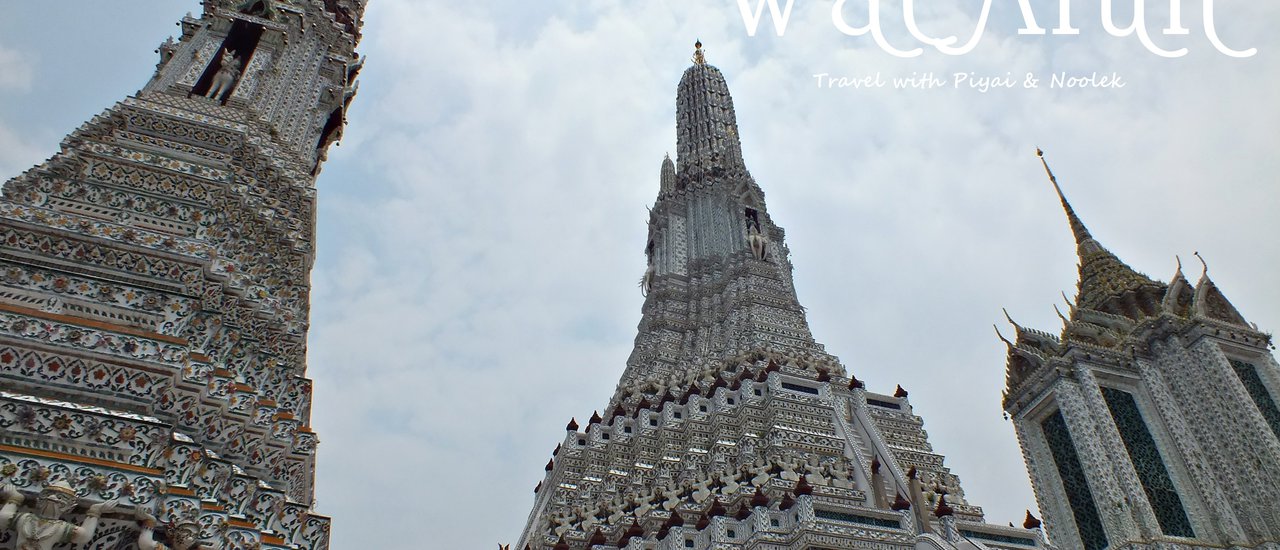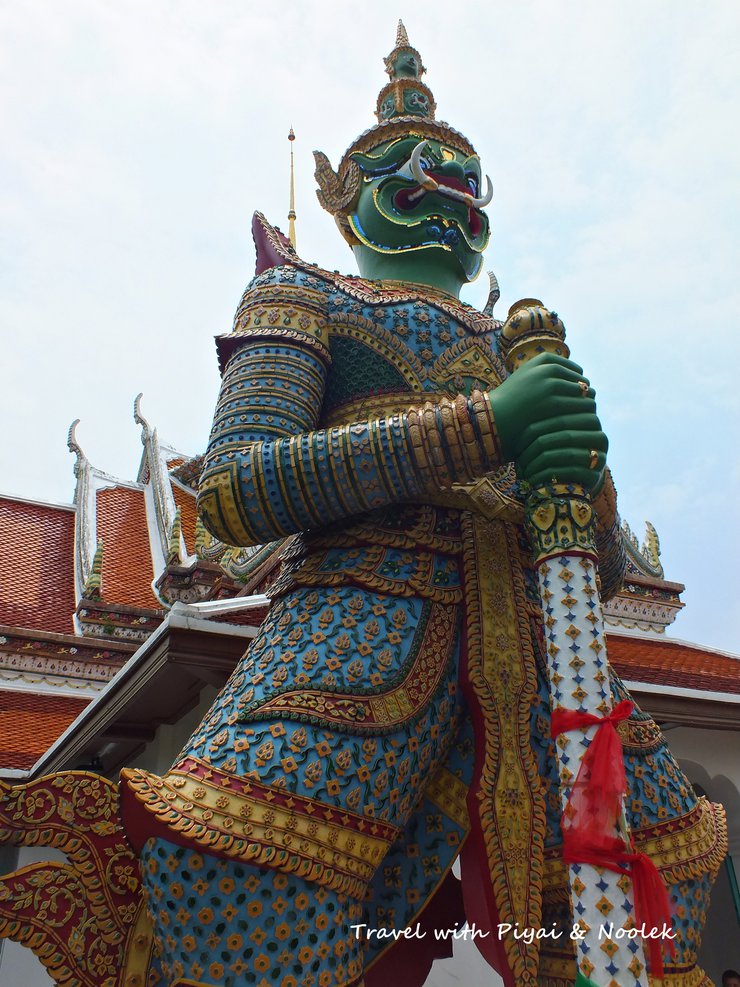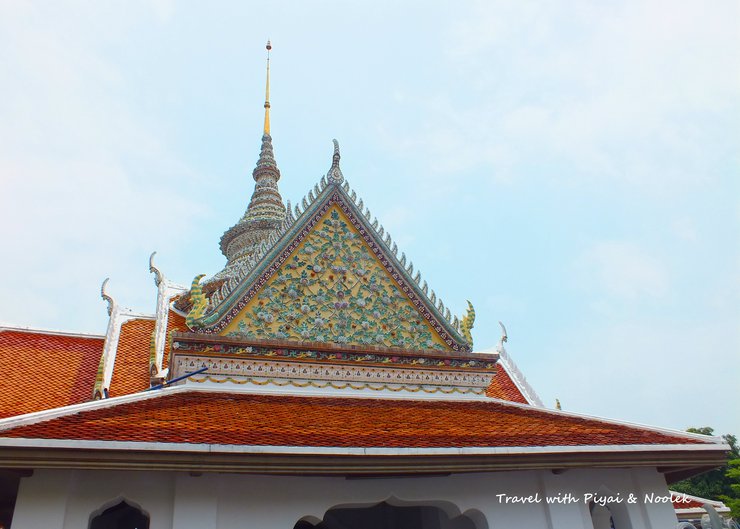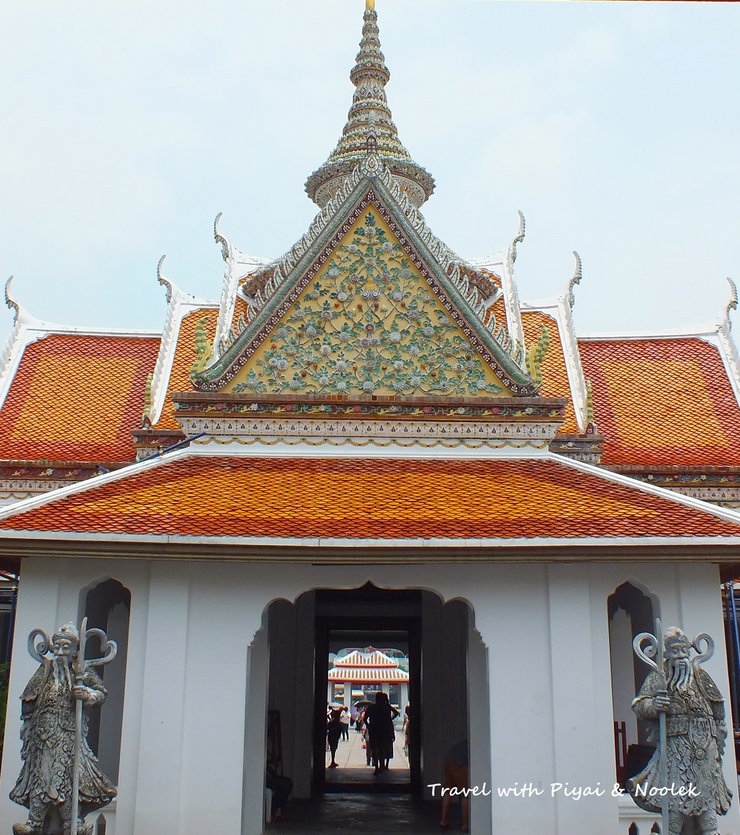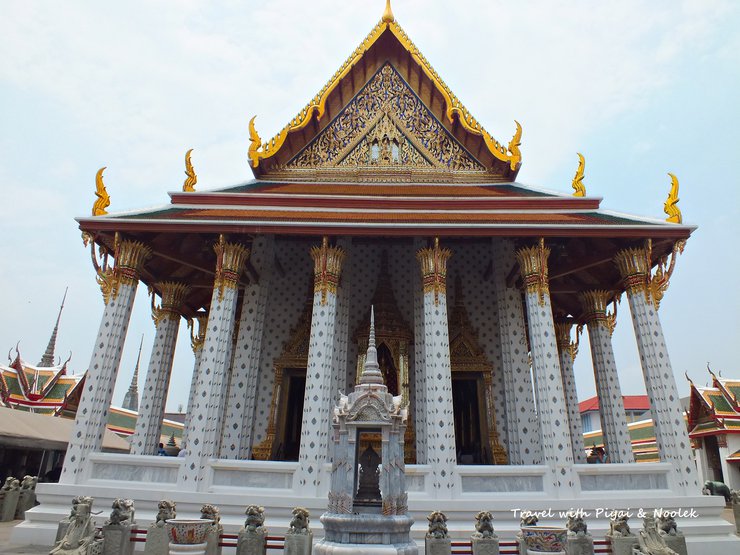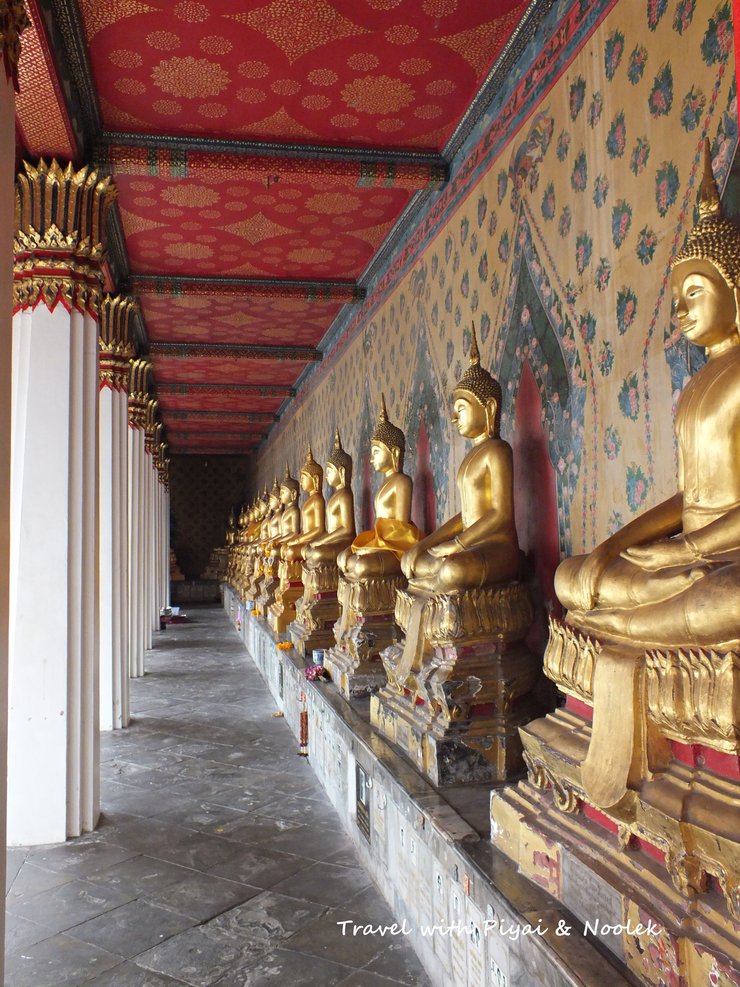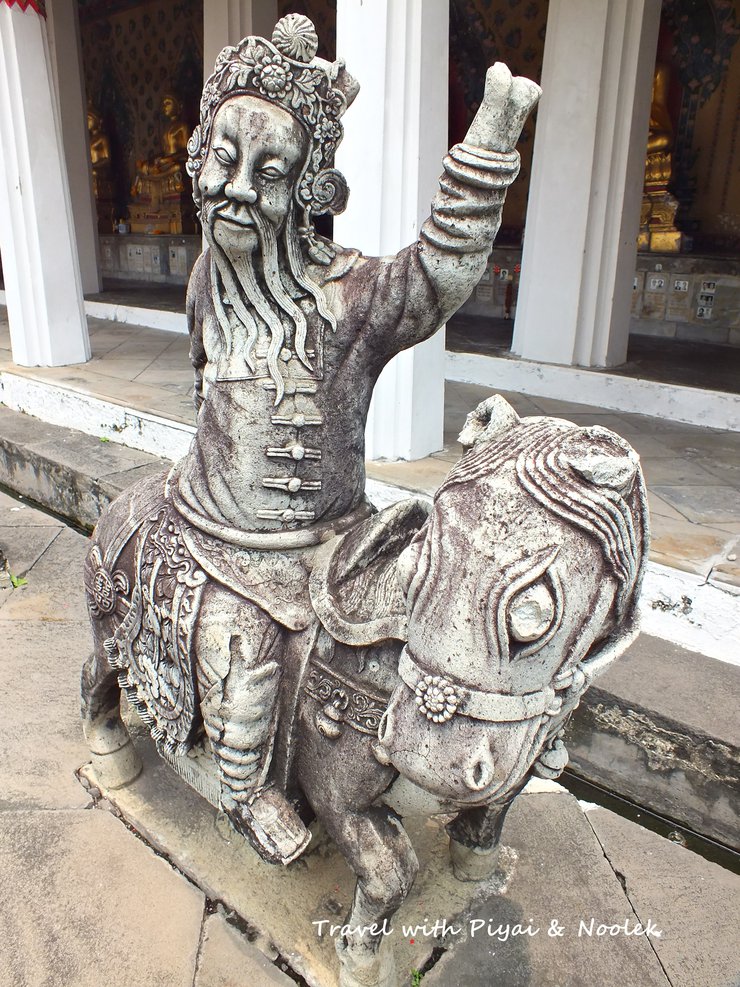On a free day, if you have nowhere to go, you don't have to travel far. Just take a trip to Rattanakosin Island, which is not far away. The place that Big Brother and Little Sister will take you to visit today is just a short ferry ride away. It's none other than "Wat Arun Ratchawararam Ratchawaramahawihan".
The Temple of Dawn (Wat Arun Ratchawararam Ratchawaramahawihan) is located on Arun Amarin Road, along the Chao Phraya River, on the Thonburi side, opposite Wat Pho on the Rattanakosin side. It can be reached by ferry from Tha Tien Pier for only 4 baht per person. Let's go and explore!
Upon disembarking from the ferry and entering the temple grounds, visitors are greeted by a pavilion in the Chinese style. However, the most striking feature is the two giant statues flanking the entrance to the ordination hall. The green giant is Thotsakan, while the white giant is Sahassadecha. These figures are the subject of a legend about the giants of Wat Jaeng who fought with the giants of Wat Pho.

Ravana
Upon entering the arched gate crowned with a spire and proceeding into the interior of the ordination hall of Wat Arun Ratchawararam Ratchawaramahawihan, one encounters the principal Buddha image enshrined within. This image, known as "Phra Phuttha Thammisara Ratcha Lokadhatu Dilok," is a representation of the Buddha in the posture of subduing Mara. The statue, crafted in the Rattanakosin style, measures three cubits and a span in width, or approximately 1.75 meters. It is said that King Rama II personally sculpted the face of this Buddha image. Additionally, beneath the throne of Phra Phuttha Thammisara Ratcha Lokadhatu Dilok lie the cremated remains of King Rama II.

Gable roof door

The only arched gate with a crown-shaped top here.

The ordination hall of the temple

Winding Balcony

Withered doll




The principal Buddha image of the temple, Phra Phutthadhammamisra Ratcha Lokathatu Dilok.

The Temple of Dawn (Wat Arun Ratchawararam Ratchawaramahawihan) is an ancient temple dating back to the Ayutthaya period. Originally known as Wat Makok (named after the district in which it is located), legend has it that King Taksin the Great intended to relocate the capital to Thonburi. As he sailed along the Chao Phraya River, he arrived at Wat Makok just as dawn broke. Recognizing this as an auspicious sign, he disembarked and paid respects at the temple's chedi (the old prang).



Later, the king ordered the renovation of the temple and renamed it Wat Jaeng to commemorate the auspicious occasion. He also built a royal palace on the west bank of the Chao Phraya River. Subsequently, the palace was expanded to include the temple grounds, elevating Wat Jaeng to the status of a royal temple within the palace during the Thonburi period. During the reign of King Rama I, a new Grand Palace was constructed on the east bank of the Chao Phraya River, and Wat Jaeng ceased to be a royal temple within the palace grounds.
The Wat Arun Ratchawararam Ratchawaramahawihan, originally known as Wat Jaeng, has undergone continuous renovations and restorations throughout history. During the reign of King Phutthaloetla Naphalai, the temple was bestowed with a new name, "Wat Arun Ratchawararam," which reflects its original meaning. Subsequently, it was elevated to the status of a "First Class Royal Temple of the Highest Grade" and ultimately became the temple of King Rama II.

The Grand and Magnificent Phra Prang of Wat Arun
The Phra Prang of Wat Arun, renowned as the "grandest and most magnificent stupa of Rattanakosin", has stood alongside the temple since the Ayutthaya period. During the reign of King Rama II, a royal decree was issued to rebuild the Phra Prang, envisioning it as a grand monument befitting the capital city. Construction commenced, but tragically, King Rama II passed away before the foundation was completed. His successor, King Rama III, continued the project, ensuring its completion.
The grandeur of the Phra Prang extends beyond its sheer size and imposing proportions. Its intricate decorations include Chinese porcelain tiles, mythical figures such as giants and monkeys carrying swords around the base, and celestial beings adorning the supporting structure.

The four porches of the pavilion, known as "Chom Buri" or "Khoo Ha," house statues of Indra riding a three-headed elephant (Erawan) instead of the customary Buddha images. The porches are also adorned with colored tiles and ceramic cups and bowls from China, featuring floral patterns and groups of Kinnari figures. These decorative elements are all connected to the belief in Mount Meru, the center of the universe.




Giant carrying



This sentence describes the architectural features of a temple complex, highlighting the symbolic representation of Mount Meru and the surrounding continents.
Here's the translation:
Moreover, this belief is further emphasized by the placement of four small prangs serving as satellite stupas at the corners of the main prang, similar to the presence of pavilions on all four sides. These corner prangs and side pavilions represent the various continents surrounding Mount Meru.

A small prang










The pavilion, which also has four directions, can be seen to be carried by angels.
The temple allows tourists to climb up to the prang for a close-up view of its beauty, but only to the first level due to the steepness of the stairs, which could pose a safety hazard. Upon closer inspection, one can appreciate the skill of ancient Thai artisans, the intricate details, and the masterful craftsmanship of Thai architecture. It is no wonder that foreigners are eager to see and experience it for themselves.

If you have the opportunity, I highly recommend visiting at least once. You will truly feel proud of our Thai identity.
After a tiring day of sightseeing, I crossed back to the Tha Tien pier. Looking for a place to eat, I saw an empty restaurant and decided to give it a try. "Arom D Cafe / Arom D Hostel" is a small restaurant and hostel in the Tha Tien area, conveniently located near major tourist attractions in the Phra Nakhon district, including Wat Phra Kaew, the Grand Palace, Wat Pho, Wat Arun, and the Museum of Siam. The hostel is located on the upper floor, while the cafe is on the lower floor, where you can enjoy a meal even if you are not staying at the hostel.



The menu mainly consisted of Italian dishes. My older brother and I agreed that since there were only two of us, ordering one pizza would be enough to satisfy our hunger. So, we went ahead and ordered it. Let's take a look at what we ordered and see what we got.

The food was delicious and the portion size was just right. The taste was good, even though it's a small restaurant. The service was good and the quality was worth the price. If you're passing by, this is a good option to consider.
Time's up, I'm exhausted. It's time to go home. Today was a worthwhile and economical day. I'll take you on another trip soon.
Piyai&Noolek
Wednesday, February 26, 2025 4:37 PM

